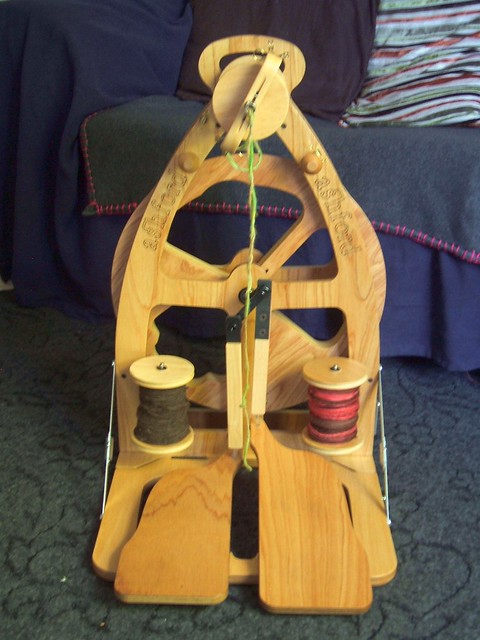No? Good. I should think not! Us young people do it too. As each generation learns from the last, the types of wheel also progress. Here are the main types that you might come across today.
Types of Wheel
Just as there are a variety of spindles available to use to spin, so are there quite a few different types of wheel. We'll start by looking at some traditional wheels.
The Great Wheel, which is also known as the walking wheel or wool wheel is a traditional wheel, invented in the 14th century is rarer these days. It was used by moving the wheel with one hand and using a long draw draft with the other hand. The Great Wheel really lives up to its name: it is a big piece of machinery, being over 5 feet in height. It is usually used to spin wool, and must really be used with carded rolags, which are suited to long-draw spinning.
Another early form of spinning wheel is the Charkha, a hand-powered wheel, which instead of standing upright spins parallel to the floor. Like the Great Wheel and drop spindles, the Charkha must be stopped in order for the yarn to be wound onto the bobbin or spindle. Interestingly, the Charkha was related to the Indian independence movement, with Mahatma Gandhi bringing it into the public eye with his teachings of self-sufficiency and independence. It was even used in an early Indian Flag.
Modern wheels are generally of three kinds: the traditional (Saxony) wheel with either single or double drive, and the castle wheel which is a single drive type. Being treadle wheels, these are powered by the spinner's foot rather than by hand. This leaves both of their hands free for drafting the fibres, allowing the short draw spinning technique to be used, if wished. Wheels can be either single or double treadle, which makes no difference to the yarn spun or the operation of the wheel, but is up to the spinner's personal preference. There is no need to stop spinning on a modern wheel to wind on the yarn as the bobbin and flyer system does this automatically.
The Double Drive wheel does exactly what it says on the tin, as its drive band goes around the spinning wheel twice: once around the bobbin whorl, once around the flyer whorl. The double drive allows the yarn to be constantly wound onto the bobbin.
The Single Drive wheel, as the name suggests, has but one drive band loop, which goes around the fly-wheel and either the bobbin or the flyer. When the spinner is making the yarn, the bobbin and flyer turn at the same time, but as the yarn is wound onto the bobbin, the flyer slows and the yarn is wound on.
[caption id="" align="alignnone" width="480" caption="Folding Castle Wheel, image copyright Ingrid Murnane."]
 [/caption]
[/caption]On a Castle Style wheel, the bobbin and flyer are placed above the wheel, rather than to one side. These wheels are often smaller than traditional wheels, so make for easy storage. Some, like mine, pictured above are made to fold up, so can be transported easily too.
Whatever type of wheel you use, the same outcome of plyed or single yarns is available to you. It really is up to your own preference.
The images in this post are copyright of Ingrid Murnane. If you wish to use the images please request permission from Ingrid.
Resources
[amazon ASIN="0908704941"]The Ashford Book of Spinning by Anne Field[/amazon]
[amazon ASIN="0295981393"]The Art of the Loom by Ann Hecht[/amazon]
The Joy of Handspinning
Buy it on Amazon:
[amazon ASIN=0908704941]
 [/amazon]
[/amazon][amazon ASIN=0295981393]
 [/amazon]
[/amazon]
[...] who invented flyer for spinning wheel historic-crafts.com [...]
ReplyDelete